
 |
|||||
|
|
|||||
|
|
|
|
||||||||||
|
|
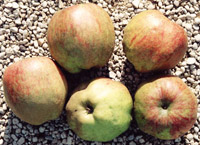 |
CORNISH GILLIFLOWER This is said to have been discovered around 1800 in a garden in Truro by Sir Christopher Hawkins who sent it to the London Horticultural Society in 1813. It was immediately popular and became known as Calville D’Angleterre in France. The name Gillyflower might come from the French Giroflier, meaning clove-bearing, because the flowers have been said to have a clove scent (like the gillyflower or garden pink). Some have called it one of the best dessert apples. The fruit is ribbed and yellow/green, heavily streaked with red. It has a sweet, richly perfumed flavour and crisp yellow flesh. Ready to pick in October, it will store until February, when the flavour becomes even more aromatic. A moderately vigorous tree, spreading and part tip bearing, so it is unsuited to growing in restricted forms. Pollination Group 4 |
||
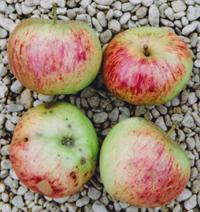 |
CORNISH TIGER An old apple tree discovered by Michael Clark, of Tewin Orchard, Hertfordshire, in the ownership of the late Patience Bagenal, of Hertingfordbury, near Hertford. Co-incidentally, she is the widow of the nephew of N.B. Bagenal, the author of the excellent book ‘The Fruit Grower’s Handbook’, published in 1949. Her orchard trees were planted in 1915, as part of the WW1 war effort. Patience, then in her 80s, still retained the original planting plan, which included two important varieties. The first was Cornish Tiger, which lived until recently, and is a name entirely unknown in the historical records. The second was the ‘lost’ Admiral Duncan, which died several years before. Cornish Tiger is a medium sized apple, green, turning yellow, with bold red stripes, that is ripe in October and will last until the end of the year. It must be assumed that its origin was in the West Country and it was, perhaps, a cider apple though it is also a good cooking apple. Michael Clark found the tree late in 2012. It has now fruited here and becomes a very pleasant eating apple in late October – crisp, very juicy, very sweet, and with a good refreshing but not strong flavour. When cooked, it keeps its shape, staying solid, and is sweet, lemony fruity and rich, but not particularly tangy. A very good dual purpose apple. It is uncommon these days to come across a named old variety, with a full provenance, that has escaped the records of the ages. Pollination Group 4 |
|||
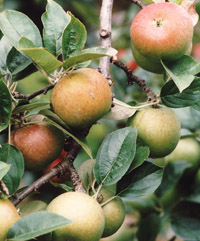 |
CORRY’S
WONDER An Oxfordshire apple bred in 1917 by Mr E. Corry Hanks
of Eynsham, from Beauty of Stoke possibly crossed with Lane’s Prince
Albert. It was introduced by the Eynsham nursery owned by F.W. and J.F.
Wastie. In 1945 it was sent by J.F. Wastie to the National Fruit Trials.
It is a late culinary apple, ripe in October and keeping until February.
Apples are large and flat, with indistinct ribs and pale-green skin, yellow
flushed and faintly streaked with pale brownish red. The flesh is soft
and sweet, with some acidity. It cooks to a purée, with a good
blend of flavour, sweetness and sharpness. Pollination Group 5 |
|||
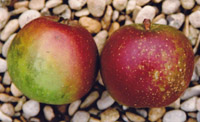 |
CORSE
HILL A triple purpose apple, best known for cider and sharp when
used before full ripeness. It was also considered a second rate cooking
apple by Hogg, in 1884, and a late dessert apple by Taylor (1946). The
National Apple Register suggested that the descriptions offered by Hogg
and Taylor were in conflict, implying that they might not have been describing
the same apple, but our experience is that the fruit is quite variable
from year to year. Only in some years does it become a sweet dessert apple.
Hogg reported that the apple came from Corse Hill, in Gloucestershire
and the Gloucestershire Orchard Group more specifically put the origin
with Mr Merchant at Corse Hill Farm. Hogg described a small to medium
sized apple, (though it can be larger) with a snouted appearance, and
with thick, shining skin, pale lemon in the shade and with a bright red
cheek in the sun often covering two thirds of the fruit. The skin is speckled
with tiny russet dots, and there is broad russet in the cavity around
the base of the stalk. The flesh is white, tender, not very juicy, brisk
and slightly sweet'. He says it is in use from December to January. Our
experience is that it is rather late to ripen and is usually solid, bitter,
sharp and sweet in early December. The shape is often quite long, and
oval to conical. Taylor said the fruit had a ‘sweet and pleasant
flavour’ and Thornhayes Nursery have described it as crisp and sweet,
but it is not a reliable dessert apple. Pollination Group 6 |
|||
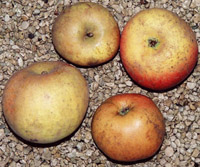 |
COTTENHAM
SEEDLING A cooking apple from Cottenham in Cambridgeshire, discovered
around 1924. In warm summers it develops a rich dessert quality. The trees
have very attractive blossom. The large fruit cooks to a bright lemon
purée, with a juicy, sharp flavour, making lovely apple sauce.
Moderately vigorous trees, which are part tip bearing. The fruit stores
well until March. Pollination Group 6 |
|||
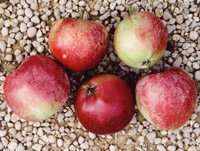 |
COTTERED
APPLE An interesting old variety brought to us by Sally Kingsley
and Colin Bayles, of Cottered, near Buntingford, Hertfordshire. The name
was unknown and simply called the Cottered Apple by us. In the garden
of their old house, were two ancient apples, this one and the Keeling
Apple, also in this catalogue, below. The Cottered Apple has an unusual
oval-conical shape and a pretty mixture of colours and blooming on the
skin. It has a distinctive open eye with very long reflexed sepals. The
flavour is tangy, sweet and complex, while the flesh is yielding and juicy.
The fruit is usually ripe just after St Swithin’s Day – the
15th July. This is one of very few apples that are ripe so early and one
of the best. They do not last beyond early September. Pollination Group
4 |
|||
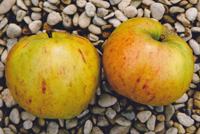 |
COUL
BLUSH Raised by Sir George Mackenzie, Bart. of Coul, Ross-shire
and first fruiting in 1827. The early descriptions, of Lindley and Hogg,
in the 19th century are at slight variance with the apple now known. For
example, they say the flesh is yellowish and crisp, and the growth upright,
with the season very late, though the apple now known has very pale flesh,
soft when kept, the growth spreading and the season somewhat earlier than
‘very late’. It was supposed to be a culinary apple, but is
now a good dual purpose apple. It might be supposed that the apple now
known is not the same as that known to Lindley and Hogg, but we have observed
quite a variation in its characteristics from year to year, and month
to month. Besides which, we live in times now remote from the 19th century
when climate was very different and we might even speculate that early
descriptions were based on fruit growing in Scotland. There is more in
common in the descriptions than sets them apart and we think the Coul
Blush at the National Collection and that with us, is the Bona Fide one.
Taken on balance and on average across years, it is a good dessert apple,
ripe in late September and crisp, juicy, sweet enough, mildly acid and
refreshing, but with only a moderate flavour. If stored for a short while,
it loses its eating qualities but becomes a very good cooking apple, going
to a purée and reviving its sweetness and tang, while developing
a rich flavour. The apples will keep until February, with care. It would
be interesting to hear any reports of its nature when grown in Scotland.
Medium sized, rounded to slightly square, with obscure ribs, skin pale
yellow with warm patches and thin scarlet streaks in the sun. The National
Collection’s accession has been tested and found to be triploid.
Our tree came from another source but should also be assumed triploid.
T* Pollination Group 3 |
|||
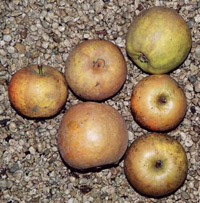 |
COURT
OF WICK Said to have arisen at the Court of Wick, at Yatton in
Somerset, but it probably existed much earlier and it is also called Wood's
Huntingdon, because it was reputedly introduced in 1790 by Wood of Huntingdon.
A late September, crisp, dessert apple with rich, sweet, yellow flesh.
The ripe apples have a complex flavour. The skin is splashed red, with
gold russeting. It stores until December. The trees are very hardy and
are said to withstand cold wind. Free spurring and good for restricted
forms. Pollination Group 5 |
|||
|
||||